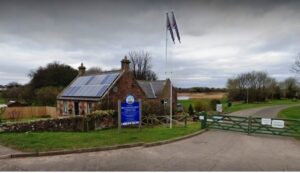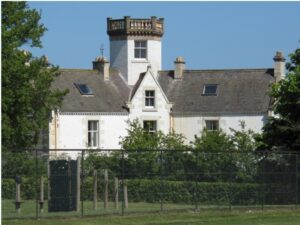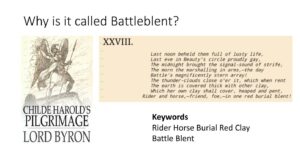October 2022
This month, we are going to look at some extracts from a talk given to the Society by Dr Pat Simpson, who did extensive research on The Battleblent, from its origins to being a hotel and then returning to be a private house. Links provided by Jim Herring.

The Battleblent was originally built as a house by the successful entrepreneur William Brodie, who took over the Seafield Brick and Tile works in 1850 and developed it into a much larger business. You can read more detail about the tile and brick works at this interesting site. Brodie passed the house onto his daughter Marion Brodie on his death in 1877. You can read a detailed description of the architectural features of the house here. This site refers to the Battleblent as a ” is a Y-plan, detached house topped by a single-storey hexagonal tower with a stone balustrade and squared piers. The house is predominantly two-storey and attic with one three-storey and attic elevation”. You can see the hexagonal tower in the photo below.

In her talk, Dr Pat Simpson posed the question: How and when did the Battleblent become a hotel? The question was asked as most local people will remember the Battleblent as a hotel, with Jim Ferguson as proprietor. There is a Facebook page related to memories of the hotel and features many photographs of events there – see here. Pat told her (extensive) audience at the talk “Brodie’s daughter Marion Brodie Sherriff took over the brickworks on his death. When the brick works ceased production, she rented out the house for the summer season. On her death, the house was sold to retired Duns farmer James Wilson whose daughters ran Battleblent as bed and breakfast from 1921”. So, perhaps a form of hotel in 1921? The building formally became a hotel in 1966 and the Fergusons ran it until it closed in 2001.

The final part of the talk looked into the origin of the name Battleblent. It was often assumed in Dunbar that the name was related to the Battle of Dunbar in 1650, but as Dr Pat Simpson discovered, this was not so. The photo above shows part of the poem Childe Harold’s Pilgrimage by Lord Byron and the audience learned that the name had come from this poem which is in 5 sections, including a dedication. If you would like to read all 186 (One hundred and eighty six!) verses of this epic poem, see here. The Battle referred to in the poem is the Battle of Waterloo and this site states that “Byron, who was a supporter of Napoleon and a harsh critic of the war effort, regarded Waterloo not as a victory but as a calamity”. The origin of the name ended an intriguing talk by DDHS member Dr Pat Simpson.

You must be logged in to post a comment.